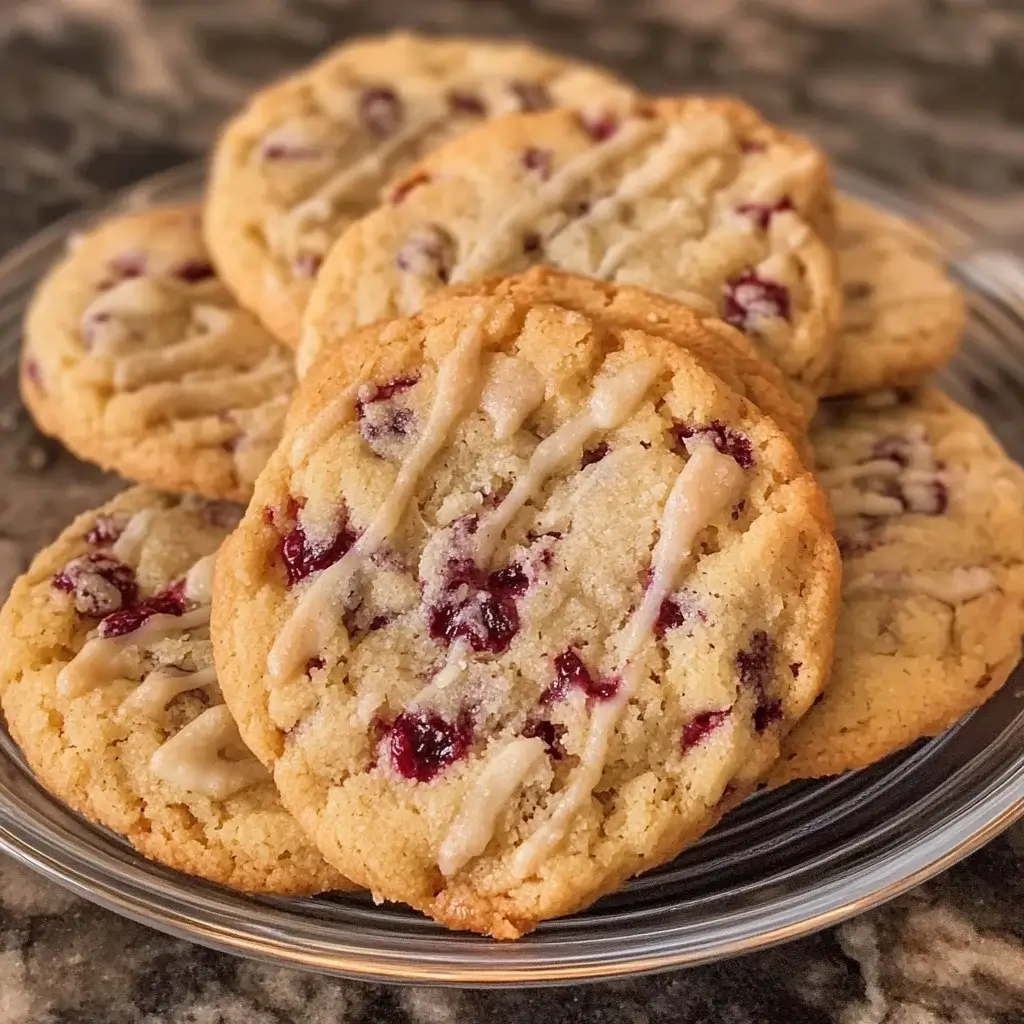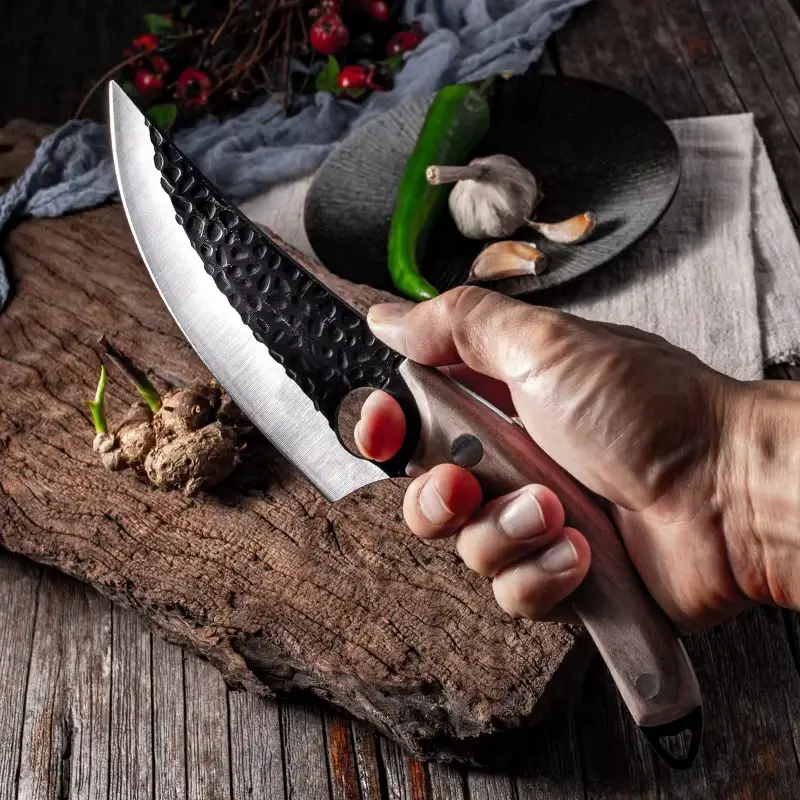The first time I pulled a batch of these Cranberry Orange Cookies from the oven, the scent alone was enough to declare them a resounding success. It wasn’t just the usual warm, buttery aroma of baking cookies; it was something more complex, more festive. The bright, zesty perfume of fresh orange mingled perfectly with the subtle tartness of cranberries and the comforting sweetness of vanilla and brown sugar. It smelled like holiday cheer captured in a cookie. My family, drawn by the irresistible fragrance, gathered in the kitchen before the cookies were even cool enough to handle properly. My youngest, usually partial to plain chocolate chip, tentatively took a bite, his eyes widening in surprise. “Wow, Mom! These are like sunshine and Christmas trees!” he declared, and honestly, I couldn’t have described the flavor combination better myself. Since that day, these Cranberry Orange Cookies have become a staple, not just during the holiday season, but whenever we crave a bite of something bright, cheerful, and utterly delicious. They strike that perfect balance – not too sweet, with bursts of tart fruit and citrusy notes that awaken the palate. The texture is equally delightful: slightly crisp edges give way to a wonderfully soft and chewy center. They’ve graced countless holiday platters, been gifted to neighbours, and enjoyed simply with a cup of tea on a quiet afternoon. Sharing this recipe feels like sharing a little piece of that warmth and joy, and I’m confident they’ll become a favourite in your home too. They are more than just a cookie; they’re an experience, a memory in the making, baked with simple ingredients but resulting in extraordinary flavour.
Ingredients
Here’s what you’ll need to create these delightful Cranberry Orange Cookies. Using fresh, quality ingredients will yield the best results:
- 2 ½ cups (315g) All-Purpose Flour: The structural base of our cookies. Spoon and level the flour into your measuring cup for accuracy; scooping directly can pack too much flour, resulting in dense cookies.
- ½ teaspoon Baking Soda: Our primary leavening agent, reacting with acidic components (like brown sugar and cranberries) to help the cookies rise and spread appropriately, contributing to a tender texture.
- ¼ teaspoon Salt: Crucial for balancing the sweetness and enhancing the overall flavour profile. Don’t skip it! Fine sea salt or regular table salt works well.
- 1 cup (226g) Unsalted Butter, Softened: Provides richness, flavour, and tenderness. “Softened” means it should yield slightly to gentle pressure but not be melted or oily. Take it out of the refrigerator about 30-60 minutes before you start baking. Using unsalted butter allows you to control the salt content precisely.
- ½ cup (100g) Granulated Sugar: Contributes to sweetness, browning, and crisp edges.
- ½ cup (110g) Packed Light Brown Sugar: Adds moisture (leading to chewiness), a deeper caramel flavour, and contributes to the cookies’ soft texture. Ensure it’s packed firmly into the measuring cup.
- 1 Large Egg, Room Temperature: Acts as a binder, adds richness, and contributes to the structure. Having it at room temperature helps it incorporate more smoothly into the butter-sugar mixture, creating a better emulsion.
- 1 Large Egg Yolk, Room Temperature: Adding an extra yolk increases richness and chewiness without adding too much extra liquid, resulting in a more tender cookie.
- 1 Tablespoon Orange Zest: This is where the magic happens! Use the zest of approximately one large orange. Zest only the bright orange outer layer, avoiding the bitter white pith underneath. This provides the intense, bright citrus flavour. Freshly grated zest is far superior to dried.
- 1 teaspoon Vanilla Extract: Enhances all the other flavours in the cookie, adding warmth and depth. Use pure vanilla extract for the best taste.
- 1 ½ cups (170g) Dried Cranberries: Provide bursts of tartness and chewy texture that contrast beautifully with the sweet dough and orange flavour. You can use regular sweetened dried cranberries (like Craisins). Briefly chopping them can ensure better distribution, especially if they are very large.
Instructions
Follow these steps carefully for perfectly baked Cranberry Orange Cookies every time:
- Prepare Dry Ingredients: In a medium-sized bowl, whisk together the all-purpose flour, baking soda, and salt. Whisking helps distribute the leavening agent and salt evenly throughout the flour, ensuring consistent cookies. Set this bowl aside.
- Cream Butter and Sugars: In the large bowl of a stand mixer fitted with the paddle attachment, or in a large bowl using a handheld electric mixer, beat the softened unsalted butter on medium speed until it’s smooth and creamy (about 1 minute). Add the granulated sugar and packed light brown sugar. Continue beating on medium-high speed for 2-3 minutes, scraping down the sides and bottom of the bowl occasionally with a rubber spatula. The mixture should become light in colour and fluffy in texture. This process, called creaming, incorporates air into the dough, which is essential for the cookies’ final texture and lift.
- Incorporate Wet Ingredients: Reduce the mixer speed to low. Add the room temperature large egg, the room temperature egg yolk, the fresh orange zest, and the pure vanilla extract. Beat on low speed just until these ingredients are combined. Be careful not to overmix at this stage; mix just enough to incorporate the eggs and flavourings smoothly. Overmixing can develop the gluten too much, leading to tougher cookies.
- Combine Wet and Dry Ingredients: With the mixer still on low speed, gradually add the flour mixture (from step 1) to the wet ingredients in the mixer bowl. Mix only until the flour streaks just disappear. Again, avoid overmixing. A few remaining streaks of flour are better than mixing too much. Overmixing develops gluten, which can make the cookies tough instead of tender and chewy.
- Fold in Cranberries: Remove the bowl from the mixer (or turn off the handheld mixer). Add the dried cranberries to the dough. Using a rubber spatula or wooden spoon, gently fold the cranberries into the dough until they are evenly distributed. This gentle folding ensures the cranberries don’t get crushed and prevents further gluten development.
- Chill the Dough (Highly Recommended): Cover the bowl tightly with plastic wrap, pressing the wrap directly onto the surface of the dough to prevent it from drying out. Refrigerate the cookie dough for at least 30 minutes. For best results (better flavour development and less spreading), chill for 1-2 hours, or even overnight (up to 72 hours). Chilling solidifies the fat (butter) in the dough. Cold fat melts more slowly in the oven, preventing the cookies from spreading too much and becoming flat. It also allows the flavours to meld and deepen.
- Preheat Oven and Prepare Baking Sheets: When you’re ready to bake, preheat your oven to 375°F (190°C). Line two large baking sheets with parchment paper or silicone baking mats. This prevents the cookies from sticking and promotes even browning on the bottoms. It also makes cleanup much easier.
- Portion the Dough: Scoop mounds of chilled cookie dough, each about 1.5 tablespoons in size (a medium cookie scoop works perfectly for uniform cookies). Roll the mounds briefly between your palms to create smooth balls. Place the dough balls onto the prepared baking sheets, leaving about 2 inches of space between each cookie to allow for spreading during baking.
- Bake the Cookies: Place one baking sheet at a time in the center rack of the preheated oven. Bake for 10-13 minutes. The cookies are done when the edges are lightly golden brown, and the centers still look slightly soft and puffy. They will continue to cook slightly from residual heat after being removed from the oven. Baking times can vary slightly depending on your oven and the exact size of your cookies, so keep an eye on them during the last few minutes. For chewier cookies, err on the side of slightly underbaking; for crispier cookies, bake a minute or two longer.
- Cool the Cookies: Remove the baking sheet from the oven. Let the cookies cool on the baking sheet for 5-10 minutes. This allows them to set up properly so they don’t fall apart when moved. After this initial cooling period, carefully transfer the cookies using a spatula to a wire rack to cool completely. Cooling on a wire rack allows air to circulate around the entire cookie, preventing the bottoms from becoming soggy.
- Repeat (If Necessary): If baking in batches, allow the baking sheet to cool slightly before placing the next batch of dough balls on it. Baking on a hot sheet can cause the cookies to spread too much. Repeat steps 8-10 until all the dough is baked.
- Store: Once completely cooled, store the Cranberry Orange Cookies in an airtight container at room temperature.
Nutrition Facts
Please note that these values are estimates and can vary based on specific ingredient brands, portion sizes, and potential modifications.
- Servings: This recipe yields approximately 24-30 cookies, depending on the size you scoop them.
- Calories Per Serving (1 cookie): Approximately 150-180 kcal.
- Total Fat: Around 8-10g per cookie. This comes primarily from the butter and egg yolk, contributing to the cookie’s rich flavour and tender texture.
- Total Carbohydrates: Approximately 18-22g per cookie. This includes sugars (from granulated/brown sugar and cranberries) and starch (from flour), providing energy and structure.
- Protein: Around 1.5-2g per cookie. Primarily from the flour and eggs, contributing minimally but essential for structure.
- Sugars: Approximately 10-13g per cookie. A combination of added sugars (granulated and brown) and natural sugars from the dried cranberries. This contributes to sweetness, browning, and moisture.
- Sodium: Approximately 60-80mg per cookie. Mainly from the added salt and naturally occurring sodium in other ingredients, essential for balancing flavours.
Preparation Time
- Active Preparation Time: Approximately 20-25 minutes (mixing the dough, zesting orange).
- Chilling Time: Minimum 30 minutes, ideally 1-2 hours (or up to 72 hours). This is mostly hands-off time.
- Baking Time: 10-13 minutes per batch.
- Total Time (including minimum chilling): Approximately 1 hour to 1 hour 40 minutes (depending on chilling duration and number of batches).
How to Serve
These Cranberry Orange Cookies are wonderfully versatile. Here are some delightful ways to serve and enjoy them:
- With Hot Beverages:
- Pair them with a steaming mug of coffee for a perfect morning or afternoon treat. The bitterness of the coffee balances the cookie’s sweetness.
- Enjoy alongside a cup of hot tea – black tea, Earl Grey (its bergamot notes complement the orange beautifully), or even a spiced herbal tea like cinnamon or chai.
- Serve with hot chocolate or warm spiced cider during colder months for an extra cozy experience.
- With Cold Milk:
- A classic pairing! A cold glass of milk is the perfect simple accompaniment for kids and adults alike.
- On Holiday Platters:
- Their festive colours (red cranberries against the golden cookie) make them a beautiful addition to Christmas or Thanksgiving cookie assortments. Arrange them alongside other holiday favourites like gingerbread cookies, shortbread, or chocolate crinkles.
- As Edible Gifts:
- Package cooled cookies attractively in cellophane bags tied with festive ribbons, in decorative tins, or in cookie boxes. They make wonderful homemade gifts for neighbours, teachers, colleagues, or party hosts. Include a small tag with the cookie name.
- With Ice Cream:
- Crumble a cookie over a scoop of vanilla bean or even butter pecan ice cream for added texture and flavour.
- Make mini ice cream sandwiches: place a small scoop of slightly softened vanilla ice cream between two cookies. Wrap and freeze until firm.
- As a Simple Dessert:
- Serve one or two cookies alongside a dollop of lightly sweetened whipped cream or a spoonful of crème fraîche for an easy yet elegant dessert.
- At Gatherings and Potlucks:
- Bring a batch to parties, potlucks, or bake sales – they are always a crowd-pleaser due to their unique and appealing flavour combination.
- Just Because:
- Sometimes the best way to serve them is simply on a plate, ready to be enjoyed whenever the craving strikes!
Additional Tips
Elevate your Cranberry Orange Cookie game with these extra pointers:
- Room Temperature Ingredients are Key: Ensure your butter, egg, and egg yolk are truly at room temperature (around 65-70°F or 18-21°C). This allows them to emulsify properly when creamed with the sugar, creating a smoother batter and a better cookie texture. Cold ingredients don’t blend as well and can result in denser cookies.
- Measure Flour Correctly: How you measure flour significantly impacts the outcome. Instead of scooping the measuring cup directly into the flour bag (which compacts it), use a spoon to lightly scoop flour into the measuring cup, then level it off with the back of a knife. This prevents adding too much flour, which is a common cause of dry, tough cookies. Using a kitchen scale for grams (315g in this recipe) is the most accurate method.
- Don’t Skip the Zest: The orange flavour comes almost entirely from the zest, which contains the citrus oils. Use a microplane or fine grater for the best results, removing only the colourful outer layer. Avoid the white pith underneath, as it’s bitter. Zest the orange directly into the bowl with the butter and sugar mixture if possible to capture all the fragrant oils.
- Embrace the Chill: While the minimum chill time is 30 minutes, chilling the dough for longer (1-2 hours or even overnight) yields superior results. It prevents excessive spreading, concentrates the flavours, and results in a chewier texture. If you’re short on time, even 30 minutes makes a difference compared to no chilling.
- Consider Chopping Cranberries: If your dried cranberries are particularly large or plump, giving them a rough chop before adding them to the dough ensures more even distribution throughout each cookie. This means you get a burst of cranberry in nearly every bite.
- Watch Baking Time Closely: Ovens vary. Start checking the cookies around the 10-minute mark. The ideal visual cue is lightly golden edges while the center still looks slightly soft and underdone. They will finish setting up as they cool on the baking sheet. Overbaking leads to dry, hard cookies.
- Cooling is Crucial: Allow the cookies to cool on the baking sheet for 5-10 minutes before transferring them to a wire rack. This “setting” time is important; moving them too soon when they are very hot and fragile can cause them to break. Cooling completely on a wire rack ensures crisp edges and prevents soggy bottoms.
- Storage Savvy: Store completely cooled cookies in an airtight container at room temperature for up to 4-5 days. To keep them extra soft, you can add a slice of bread to the container (replace it every couple of days); the cookies will absorb moisture from the bread. For longer storage, freeze baked cookies or dough balls (see FAQ).
FAQ Section
Here are answers to some frequently asked questions about making Cranberry Orange Cookies:
- Can I use fresh or frozen cranberries instead of dried?
- Yes, but it will significantly change the texture and moisture level. Fresh or frozen cranberries (do not thaw frozen ones first) will release more liquid during baking, potentially making the cookies cakier and requiring a slightly longer baking time. They also provide a much tarter flavour punch. Roughly chop them before adding. You might need to adjust the recipe slightly (perhaps a tablespoon more flour) if using fresh/frozen. Dried cranberries offer a chewy texture and concentrated sweetness that works particularly well in this recipe.
- Can I make the cookie dough ahead of time?
- Absolutely! This dough benefits from chilling. You can prepare the dough, cover it tightly (plastic wrap pressed against the surface), and refrigerate it for up to 3 days (72 hours). The flavour actually deepens over time. When ready to bake, let the dough sit at room temperature for 10-15 minutes if it’s very firm, just enough to make scooping easier, then proceed with portioning and baking as directed. You can also freeze the dough (see below).
- Why did my cookies spread too much and become flat?
- Several factors can cause excessive spreading:
- Butter too soft/melted: Ensure butter is properly softened, not greasy or melted.
- Insufficient chilling: Chilling solidifies the fat, preventing rapid melting and spreading in the oven. Don’t skip this step!
- Oven temperature too low: An inaccurate oven thermometer might reveal your oven isn’t hot enough. Cookies bake slower and spread more at lower temps.
- Baking sheets too warm: Always cool baking sheets between batches.
- Too much sugar or leavening: Double-check measurements.
- Several factors can cause excessive spreading:
- Can I make these cookies gluten-free?
- Yes, you can try substituting a good quality measure-for-measure gluten-free flour blend that contains xanthan gum. The texture might be slightly different (potentially sandier or crumblier depending on the blend used). Ensure all other ingredients (like vanilla) are certified gluten-free if needed for severe allergies. Results can vary significantly between GF flour blends.
- Can I make these cookies vegan?
- Making these vegan requires several substitutions. Use a vegan butter substitute (stick form works best) instead of dairy butter. Replace the egg and egg yolk with a vegan egg replacer (like flax eggs – 1 tbsp flaxseed meal + 3 tbsp water per egg, let sit 5 mins) or a commercial egg substitute suitable for baking. Ensure your sugars are vegan (some white/brown sugars are processed using bone char). The texture and flavour will differ from the original recipe but can still be delicious.
- I don’t have fresh oranges. Can I use orange extract or orange juice?
- Orange zest provides the best, brightest, most authentic orange flavour from its oils. Orange extract can be used as a substitute, but it tastes more artificial. Start with about ½ to ¾ teaspoon of orange extract in place of the tablespoon of zest and adjust to taste (add it with the vanilla). Orange juice adds liquid and acidity but very little orange flavour compared to zest; it’s not a suitable substitute for the zest in this recipe as it would alter the dough’s consistency.
- How long do these cookies last? How should I store them?
- Stored in an airtight container at room temperature, these cookies will stay fresh for about 4-5 days. Their texture will soften slightly over time. For longer storage, you can freeze the baked cookies (once completely cooled) in an airtight container or freezer bag for up to 2-3 months. Thaw at room temperature. You can also freeze the unbaked cookie dough balls (see next question).
- Can I freeze the cookie dough? How do I bake from frozen?
- Yes! This dough freezes beautifully. Scoop the dough balls onto a parchment-lined baking sheet. Freeze until solid (about 1-2 hours). Transfer the frozen dough balls to a labelled airtight container or freezer bag. They can be frozen for up to 3 months. To bake from frozen, place the frozen dough balls on a parchment-lined baking sheet and bake as directed, adding 1-3 minutes to the total baking time. There’s no need to thaw them first. This is perfect for having fresh-baked cookies on demand!

Cranberry Orange Cookies
Ingredients
Here’s what you’ll need to create these delightful Cranberry Orange Cookies. Using fresh, quality ingredients will yield the best results:
- 2 ½ cups (315g) All-Purpose Flour: The structural base of our cookies. Spoon and level the flour into your measuring cup for accuracy; scooping directly can pack too much flour, resulting in dense cookies.
- ½ teaspoon Baking Soda: Our primary leavening agent, reacting with acidic components (like brown sugar and cranberries) to help the cookies rise and spread appropriately, contributing to a tender texture.
- ¼ teaspoon Salt: Crucial for balancing the sweetness and enhancing the overall flavour profile. Don’t skip it! Fine sea salt or regular table salt works well.
- 1 cup (226g) Unsalted Butter, Softened: Provides richness, flavour, and tenderness. “Softened” means it should yield slightly to gentle pressure but not be melted or oily. Take it out of the refrigerator about 30–60 minutes before you start baking. Using unsalted butter allows you to control the salt content precisely.
- ½ cup (100g) Granulated Sugar: Contributes to sweetness, browning, and crisp edges.
- ½ cup (110g) Packed Light Brown Sugar: Adds moisture (leading to chewiness), a deeper caramel flavour, and contributes to the cookies’ soft texture. Ensure it’s packed firmly into the measuring cup.
- 1 Large Egg, Room Temperature: Acts as a binder, adds richness, and contributes to the structure. Having it at room temperature helps it incorporate more smoothly into the butter-sugar mixture, creating a better emulsion.
- 1 Large Egg Yolk, Room Temperature: Adding an extra yolk increases richness and chewiness without adding too much extra liquid, resulting in a more tender cookie.
- 1 Tablespoon Orange Zest: This is where the magic happens! Use the zest of approximately one large orange. Zest only the bright orange outer layer, avoiding the bitter white pith underneath. This provides the intense, bright citrus flavour. Freshly grated zest is far superior to dried.
- 1 teaspoon Vanilla Extract: Enhances all the other flavours in the cookie, adding warmth and depth. Use pure vanilla extract for the best taste.
- 1 ½ cups (170g) Dried Cranberries: Provide bursts of tartness and chewy texture that contrast beautifully with the sweet dough and orange flavour. You can use regular sweetened dried cranberries (like Craisins). Briefly chopping them can ensure better distribution, especially if they are very large.
Instructions
Follow these steps carefully for perfectly baked Cranberry Orange Cookies every time:
- Prepare Dry Ingredients: In a medium-sized bowl, whisk together the all-purpose flour, baking soda, and salt. Whisking helps distribute the leavening agent and salt evenly throughout the flour, ensuring consistent cookies. Set this bowl aside.
- Cream Butter and Sugars: In the large bowl of a stand mixer fitted with the paddle attachment, or in a large bowl using a handheld electric mixer, beat the softened unsalted butter on medium speed until it’s smooth and creamy (about 1 minute). Add the granulated sugar and packed light brown sugar. Continue beating on medium-high speed for 2-3 minutes, scraping down the sides and bottom of the bowl occasionally with a rubber spatula. The mixture should become light in colour and fluffy in texture. This process, called creaming, incorporates air into the dough, which is essential for the cookies’ final texture and lift.
- Incorporate Wet Ingredients: Reduce the mixer speed to low. Add the room temperature large egg, the room temperature egg yolk, the fresh orange zest, and the pure vanilla extract. Beat on low speed just until these ingredients are combined. Be careful not to overmix at this stage; mix just enough to incorporate the eggs and flavourings smoothly. Overmixing can develop the gluten too much, leading to tougher cookies.
- Combine Wet and Dry Ingredients: With the mixer still on low speed, gradually add the flour mixture (from step 1) to the wet ingredients in the mixer bowl. Mix only until the flour streaks just disappear. Again, avoid overmixing. A few remaining streaks of flour are better than mixing too much. Overmixing develops gluten, which can make the cookies tough instead of tender and chewy.
- Fold in Cranberries: Remove the bowl from the mixer (or turn off the handheld mixer). Add the dried cranberries to the dough. Using a rubber spatula or wooden spoon, gently fold the cranberries into the dough until they are evenly distributed. This gentle folding ensures the cranberries don’t get crushed and prevents further gluten development.
- Chill the Dough (Highly Recommended): Cover the bowl tightly with plastic wrap, pressing the wrap directly onto the surface of the dough to prevent it from drying out. Refrigerate the cookie dough for at least 30 minutes. For best results (better flavour development and less spreading), chill for 1-2 hours, or even overnight (up to 72 hours). Chilling solidifies the fat (butter) in the dough. Cold fat melts more slowly in the oven, preventing the cookies from spreading too much and becoming flat. It also allows the flavours to meld and deepen.
- Preheat Oven and Prepare Baking Sheets: When you’re ready to bake, preheat your oven to 375°F (190°C). Line two large baking sheets with parchment paper or silicone baking mats. This prevents the cookies from sticking and promotes even browning on the bottoms. It also makes cleanup much easier.
- Portion the Dough: Scoop mounds of chilled cookie dough, each about 1.5 tablespoons in size (a medium cookie scoop works perfectly for uniform cookies). Roll the mounds briefly between your palms to create smooth balls. Place the dough balls onto the prepared baking sheets, leaving about 2 inches of space between each cookie to allow for spreading during baking.
- Bake the Cookies: Place one baking sheet at a time in the center rack of the preheated oven. Bake for 10-13 minutes. The cookies are done when the edges are lightly golden brown, and the centers still look slightly soft and puffy. They will continue to cook slightly from residual heat after being removed from the oven. Baking times can vary slightly depending on your oven and the exact size of your cookies, so keep an eye on them during the last few minutes. For chewier cookies, err on the side of slightly underbaking; for crispier cookies, bake a minute or two longer.
- Cool the Cookies: Remove the baking sheet from the oven. Let the cookies cool on the baking sheet for 5-10 minutes. This allows them to set up properly so they don’t fall apart when moved. After this initial cooling period, carefully transfer the cookies using a spatula to a wire rack to cool completely. Cooling on a wire rack allows air to circulate around the entire cookie, preventing the bottoms from becoming soggy.
- Repeat (If Necessary): If baking in batches, allow the baking sheet to cool slightly before placing the next batch of dough balls on it. Baking on a hot sheet can cause the cookies to spread too much. Repeat steps 8-10 until all the dough is baked.
- Store: Once completely cooled, store the Cranberry Orange Cookies in an airtight container at room temperature.
Nutrition
- Serving Size: one normal portion
- Calories: 180
- Sugar: 13g
- Sodium: 80mg
- Carbohydrates: 22g
- Fiber: 2g





